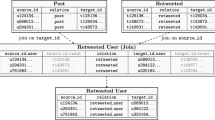Abstract
Social media platforms like Twitter revolutionized online communication. But this new era of interaction has brought with it a challenge—the widespread presence and influence of bot accounts. These bots are rapidly evolving, making traditional detection methods increasingly ineffective and allowing malicious actors to influence public discourse. While existing bot detection methods report high performance, such results might actually be connected to shortcomings in dataset collection and labeling practices, rather than reflecting their true ability to detect bots, casting doubt on their true reliability. Our study introduces higher-order behavior-based relations, including Co-Retweet, and Co-Hashtag, derived from the TwiBot-22 dataset. By leveraging these new relations in the BotRGCN architecture, we shift the emphasis from isolated accounts to coordinated group dynamics, making it more challenging for bot developers to evade detection. This strategy not only acknowledges the limitations and inherent biases presented in existing bot detection techniques, but also presents a way to address them. Our experiments support this approach as a promising way forward to tackle challenges in bot detection.
Access this chapter
Tax calculation will be finalised at checkout
Purchases are for personal use only
Similar content being viewed by others
Notes
- 1.
- 2.
- 3.
Somewhat counter-intuitively, the total following and follower counts do not match. This is due to specifics of data collection, see [6] for insights into the process.
- 4.
References
Cinelli, M., Cresci, S., Quattrociocchi, W., Tesconi, M., Zola, P.: Coordinated inauthentic behavior and information spreading on twitter. Decision Support Syst. 160, 113,819 (2022)
Cresci, S.: A decade of social bot detection. Commun. ACM 63(10), 72–83 (2020)
Cresci, S., Di Pietro, R., Petrocchi, M., Spognardi, A., Tesconi, M.: The paradigm-shift of social spambots: evidence, theories, and tools for the arms race. In: Proceedings of the 26th International Conference on World Wide Web Companion, pp. 963–972 (2017)
Cresci, S., Lillo, F., Regoli, D., Tardelli, S., Tesconi, M.: Cashtag piggybacking: uncovering spam and bot activity in stock microblogs on twitter. ACM Trans. Web (TWEB) 13(2), 1–27 (2019)
Elmas, T., Overdorf, R., Aberer, K.: Characterizing retweet bots: The case of black market accounts. In: Proceedings of the International AAAI Conference on Web and Social Media, vol. 16, pp. 171–182 (2022)
Feng, S., Tan, Z., Wan, H., Wang, N., Chen, Z., Zhang, B., Zheng, Q., Zhang, W., Lei, Z., Yang, S., et al.: Twibot-22: towards graph-based twitter bot detection. Adv. Neural. Inf. Process. Syst. 35, 35254–35269 (2022)
Feng, S., Wan, H., Wang, N., Luo, M.: Botrgcn: Twitter bot detection with relational graph convolutional networks. In: Proceedings of the 2021 IEEE/ACM International Conference on Advances in Social Networks Analysis and Mining, pp. 236–239 (2021)
Hays, C., Schutzman, Z., Raghavan, M., Walk, E., Zimmer, P.: Simplistic collection and labeling practices limit the utility of benchmark datasets for twitter bot detection. In: Proceedings of the ACM Web Conference 2023, pp. 3660–3669 (2023)
Keller, F.B., Schoch, D., Stier, S., Yang, J.: Political astroturfing on twitter: how to coordinate a disinformation campaign. Polit. Commun. 37(2), 256–280 (2020)
Martini, F., Samula, P., Keller, T.R., Klinger, U.: Bot, or not? comparing three methods for detecting social bots in five political discourses. Big data & society 8(2), 20539517211033,566 (2021)
Rauchfleisch, A., Kaiser, J.: The false positive problem of automatic bot detection in social science research. PloS one 15(10), e0241,045 (2020)
Vargas, L., Emami, P., Traynor, P.: On the detection of disinformation campaign activity with network analysis. In: Proceedings of the 2020 ACM SIGSAC Conference on Cloud Computing Security Workshop, pp. 133–146 (2020)
Varol, O., Ferrara, E., Davis, C., Menczer, F., Flammini, A.: Online human-bot interactions: Detection, estimation, and characterization. In: Proceedings of the International AAAI Conference on Web and social media, vol. 11, pp. 280–289 (2017)
Acknowledgements
The authors thank Ali Alhosseini for his guidance during the early conceptual phase and Lukas Drews for his collaboration in the initial experiments.
Author information
Authors and Affiliations
Corresponding author
Editor information
Editors and Affiliations
Rights and permissions
Copyright information
© 2024 The Author(s), under exclusive license to Springer Nature Switzerland AG
About this paper
Cite this paper
Reiche, S., Cohen, S., Simonov, K., Friedrich, T. (2024). Beyond Following: Augmenting Bot Detection with the Integration of Behavioral Patterns. In: Cherifi, H., Rocha, L.M., Cherifi, C., Donduran, M. (eds) Complex Networks & Their Applications XII. COMPLEX NETWORKS 2023. Studies in Computational Intelligence, vol 1141. Springer, Cham. https://doi.org/10.1007/978-3-031-53468-3_21
Download citation
DOI: https://doi.org/10.1007/978-3-031-53468-3_21
Published:
Publisher Name: Springer, Cham
Print ISBN: 978-3-031-53467-6
Online ISBN: 978-3-031-53468-3
eBook Packages: EngineeringEngineering (R0)




